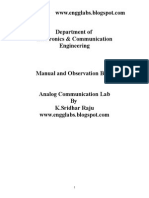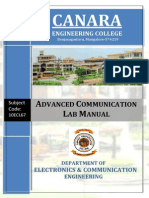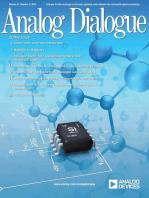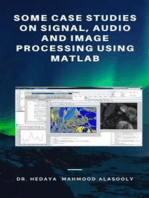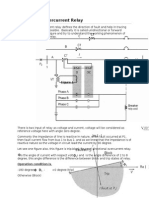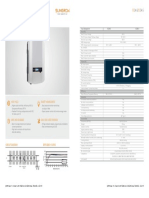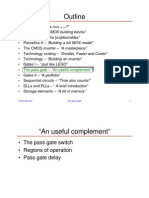Lab Report 6 Communication
Uploaded by
Husham EinaLab Report 6 Communication
Uploaded by
Husham EinaPre – Lab:
----------
College of Engineering
In-Lab Quiz: -------
3
Department of Electrical Engineering
15
Total
Lab Report: --------
10
Course Number: ELEC 342
Course Name: Communication Engineering Lab
Lab Number: 6
Title of the Lab: QAM Modulation and Demodulation
Group Number in Blackboard: 6
Section: L02
Student Name 1 : Alaaldeen Alkiswani
ID Number 201516903
Student Name 2 : Ayman Khalfallah
ID Number 201602422
Student Name 3 : Mohammad Eldeeb
ID Number 201506622
Date Performed: 27/2/2019 ; Date Submitted: 12/3/2019
Instructor: Eng. Amith Khandakar
ELEC 342 [COMMUNICATIONS ENGINEERING LAB MANUAL]
Lab #6: QAM Modulation and Demodulation
1. Objective
To build and verify the results of a quadrature amplitude modulator and
demodulator.
2. Equipment
Hardware: Computer, Emona TIMS.
Software: Matlab/Simulink, Tutor TIMS software.
3. Related Theory
QAM is the Quadrature Amplitude Modulation. It is used in applications including
microwave radio, DVB-C and others. In this lab, there are two messages are modulated with
carrier that have same frequency but have phase shift of 90 degrees. The two signals are
added and transmitted in the same channel. The blocks are shown blow
Figure1: Modulation and Demodulation of QAM signal.
Figure 1, shows the steps of modulating and demodulating of the QAM signal. If the carrier
in demodulation had small phase different , the demodulated signal will have interfere at
the output.
2 Submitted to Engr. Amith Khandakar
ELEC 342 [COMMUNICATIONS ENGINEERING LAB MANUAL]
4. Summary of Results.
4.1. Pre Lab: The task was to do QAM modulation and demodulation on the
TutorTIMS program and the results of each step is shown below:
Figure 1 shows the signal after modulation with the original message 1. Where the
two messages are multiplied by the carriers that are phase shifted.
Figure 1 - Modulated Signal
Figure 2 compares the received message 1 after demodulation with the original
message and it is clear that the message was successfully demodulated and the only
difference is a small phase shift.
Figure 2 - Received Message 1
3 Submitted to Engr. Amith Khandakar
ELEC 342 [COMMUNICATIONS ENGINEERING LAB MANUAL]
Figure 3 compares the second received message with the original one and it shows
the same results as the other message where there is only a small phase shift while
the other properties of the message are there.
Figure 3 - Received Message 2
4.2. Lab work: The task of the lab was to perform QAM modulation and demodulation
on two messages with different frequencies.
The result of each step is discussed and shown below in time and frequency
domains:
The following 4 figures show the original first message and its modulation both in
time and frequency domains.
Figure 4 - Message 1 (time)
4 Submitted to Engr. Amith Khandakar
ELEC 342 [COMMUNICATIONS ENGINEERING LAB MANUAL]
Figure 5 - Message 1 (frequency)
Figure 6 - Modulated message 1 (time)
5 Submitted to Engr. Amith Khandakar
ELEC 342 [COMMUNICATIONS ENGINEERING LAB MANUAL]
Figure 7 - Modulated message 1 (frequency)
Figures 8-11 show the second message before and after modulation in time and
frequency domains.
Figure 8 - Message 2 (time)
6 Submitted to Engr. Amith Khandakar
ELEC 342 [COMMUNICATIONS ENGINEERING LAB MANUAL]
Figure 9 - Message 2 (frequency)
Figure 10 - Modulated message 2 (time)
7 Submitted to Engr. Amith Khandakar
ELEC 342 [COMMUNICATIONS ENGINEERING LAB MANUAL]
Figure 11 - Modulated message 2 (frequency)
Figures 12 & 13 show the signal after adding the two modulations. As seen in Figure
13, there are two peaks in the frequency domain, one for each message.
Figure 12 - QAM (time)
8 Submitted to Engr. Amith Khandakar
ELEC 342 [COMMUNICATIONS ENGINEERING LAB MANUAL]
Figure 13 - QAM (frequency)
Figures 14-17 show the signal after multiplying it again with the same carriers as the
ones in the first step. If the phase of the carriers is different from what it was in the
first step, then retrieving the message will not happen or will be difficult and noisy.
Figure 14 - After multiplier 1 (time)
9 Submitted to Engr. Amith Khandakar
ELEC 342 [COMMUNICATIONS ENGINEERING LAB MANUAL]
Figure 15 - After multiplier 1 (frequency)
Figure 16 - After multiplier 2 (time)
10 Submitted to Engr. Amith Khandakar
ELEC 342 [COMMUNICATIONS ENGINEERING LAB MANUAL]
Figure 17 - After multiplier 2 (frequency)
The filtering is the only part left of the demodulation to get the two original
messages back at the receiver side. The results of the filtering are shown below:
Figure 18 - Filtered message 1 (time)
11 Submitted to Engr. Amith Khandakar
ELEC 342 [COMMUNICATIONS ENGINEERING LAB MANUAL]
Figure 19 - Filtered message 1 (frequency)
Figure 20 - Filtered message 2 (time)
12 Submitted to Engr. Amith Khandakar
ELEC 342 [COMMUNICATIONS ENGINEERING LAB MANUAL]
Figure 21 - Filtered message 2 (frequency)
4.3. Post Lab: The
Figure 22 – Simulink connections ( modulation and demodulation )
13 Submitted to Engr. Amith Khandakar
[COMMUNICATIONS
ELEC 342 ENGINEERING LAB MANUAL]
Figure 23 – message 1 (time domain) Figure 24 – message 1
(frequency domain)
Figure 26 – Carrier 1 (frequency
domain)
Figure 25 – Carrier 1 (time domain)
Submitted to Engr. Amith Khandakar
14
[COMMUNICATIONS
ELEC 342 ENGINEERING LAB MANUAL]
Figure 27 – message 2 (time domain) Figure 28 – message 2 (frequency domain)
Figure 29 – Carrier 2 Figure 30 – Carrier 2
(time domain) (frequency domain)
Figure 32 – Demodulated message 1 (frequency domain)
Figure 31 – Demodulated message 1 (time domain)
Submitted to Engr. Amith Khandakar
15
[COMMUNICATIONS
ELEC 342 ENGINEERING LAB MANUAL]
Figure 34 – Demodulated message 1
Figure 33 – Demodulated message before LPF (frequency domain)
1 before LPF (time domain)
Figure 35 – Demodulated message 1 after LPF (time domain) Figure 36 – Demodulated message 1 after LPF (frequency
domain
Figure 37 – message 2 (time domain)
Figure 38 –message 2 (frequency domain)
Submitted to Engr. Amith Khandakar
16
[COMMUNICATIONS
ELEC 342 ENGINEERING LAB MANUAL]
Figure 39 – Demodulated message 2 before LPF (time
domain) Figure 40 – Demodulated message 2 before LPF (frequency
domain)
Figure 41 – Demodulated message 2 after LPF (time domain) Figure 42 – Demodulated message 2
after LPF (frequency domain)
Submitted to Engr. Amith Khandakar
17
ELEC 342 [COMMUNICATIONS ENGINEERING LAB MANUAL]
5. Analysis of Results.
5.1. Data analysis
The results we took form the prelab are more specific and accurate than the results from the
lab because prelab is all simulated. The lab results are good put they are not specific as the
pre lab because in the lab we are facing problems such weird jumping of the second
massage. The QAM modulation and demodulation in the post lab was done in the Simulink
and the results are close to the prelab and in lab task, and using the QFM is better because it
uses minimum number of bandwidth and make the signals in the best range and on the same
spectrum
5.2. Comparison and Discussion of Results
The simulated results are great and the gotten messages are practically identical to the first
messages. The results anyway are likewise great, however they are not as good as the
simulated results. The original message has shrunk in amplitude and that is fine. The second
massage shown some jumping effect in it. The right frequency and the right shape leads to
the right massage. The change in the second massage it could be because the first massage
interference because of different phase of the carriers.
6. Conclusion.
In conclusion, the aim of this experiment is to make sure of the results of the QAM
modulator and demodulated signals. Wifi is basically used by QAM, and QAM increases
radio transmission efficiency. Moreover, the noise caused by QAM is necessary to change
high signal into different location. At the end, the lab was done properly and completely.
References:
notes, e. (2019). QAM Modulators & Demodulators | Electronics Notes. Retrieved from https://www.electronics-
notes.com/articles/radio/modulation/quadrature-amplitude-modulation-qam-modulator-demodulator.php.
HALIMI. (2019). QUADRATURE AMPLITUDE MODULATION. Retrieved from
https://www.slideshare.net/ahsanhalini/quadrature-amplitude-modulation-54999195.
18 Submitted to Engr. Amith Khandakar
You might also like
- Ec3461- Communication System Lab ManualNo ratings yetEc3461- Communication System Lab Manual117 pages
- Analogue Digital Communication Manual August 2015No ratings yetAnalogue Digital Communication Manual August 201596 pages
- B.N.M. Institute of Technology: VII SemesterNo ratings yetB.N.M. Institute of Technology: VII Semester54 pages
- Principles of Electronic Communication Model Question Paper - Set-1No ratings yetPrinciples of Electronic Communication Model Question Paper - Set-12 pages
- Digital Communications: Lab Manual (Student Copy)No ratings yetDigital Communications: Lab Manual (Student Copy)78 pages
- Communication System (LC-ECE204G) LAB ManualNo ratings yetCommunication System (LC-ECE204G) LAB Manual54 pages
- Analog Communications Lab Manual - AsraoNo ratings yetAnalog Communications Lab Manual - Asrao128 pages
- Reception of Amplitude Modulated Signals AM DemodulationNo ratings yetReception of Amplitude Modulated Signals AM Demodulation9 pages
- Analog & Digital Communications Lab Manual100% (1)Analog & Digital Communications Lab Manual57 pages
- Fundamentals of Electronics 3: Discrete-time Signals and Systems, and Quantized Level SystemsFrom EverandFundamentals of Electronics 3: Discrete-time Signals and Systems, and Quantized Level SystemsNo ratings yet
- Analysis and Design of Multicell DC/DC Converters Using Vectorized ModelsFrom EverandAnalysis and Design of Multicell DC/DC Converters Using Vectorized ModelsNo ratings yet
- Some Case Studies on Signal, Audio and Image Processing Using MatlabFrom EverandSome Case Studies on Signal, Audio and Image Processing Using MatlabNo ratings yet
- Electromagnetic Compatibility (EMC) Design and Test Case AnalysisFrom EverandElectromagnetic Compatibility (EMC) Design and Test Case AnalysisNo ratings yet
- Electrical Distribution System of a Skyscraper in the United StatesFrom EverandElectrical Distribution System of a Skyscraper in the United StatesNo ratings yet
- Directional Overcurrent Relay-QnowledgeNo ratings yetDirectional Overcurrent Relay-Qnowledge13 pages
- Quarter Wave Cavity Filters Using Copper PipeNo ratings yetQuarter Wave Cavity Filters Using Copper Pipe9 pages
- Sabertooth 2x60 User's Guide: April 2012No ratings yetSabertooth 2x60 User's Guide: April 201225 pages
- P N M T: PNMT (Java Version) Operation ManualNo ratings yetP N M T: PNMT (Java Version) Operation Manual93 pages
- Supplier Document Cover Sheet: RNP DCU Plant ProjectNo ratings yetSupplier Document Cover Sheet: RNP DCU Plant Project12 pages
- Measurement of The Pulses Generated by The High Power Electromagnetic Pulse GeneratorNo ratings yetMeasurement of The Pulses Generated by The High Power Electromagnetic Pulse Generator5 pages
- 2-2a Relay Selection Guide-Motor ProtectionNo ratings yet2-2a Relay Selection Guide-Motor Protection14 pages
- KSG-4.6K-DM / KSG-4.9K-DM / KSG-5K-DM / KSG-5.2K-DM: String Grid-Tied PV Inverter NG Grid-Tied PV InverterNo ratings yetKSG-4.6K-DM / KSG-4.9K-DM / KSG-5K-DM / KSG-5.2K-DM: String Grid-Tied PV Inverter NG Grid-Tied PV Inverter1 page
- The Whole Truth ... : Van Den Hul The Second (Balanced)No ratings yetThe Whole Truth ... : Van Den Hul The Second (Balanced)2 pages
- Valcom V 9945A Single Tone Interrupted Warble Tone HornNo ratings yetValcom V 9945A Single Tone Interrupted Warble Tone Horn4 pages
- Electromagnetic Interference EMI in Power Supplies PDF100% (1)Electromagnetic Interference EMI in Power Supplies PDF16 pages
- Micro-Programmed Versus Hardwired Control Units The Control UnitNo ratings yetMicro-Programmed Versus Hardwired Control Units The Control Unit11 pages
- Principles of Electronic Communication Model Question Paper - Set-1Principles of Electronic Communication Model Question Paper - Set-1
- Reception of Amplitude Modulated Signals AM DemodulationReception of Amplitude Modulated Signals AM Demodulation
- Digital Signal Processing Using the ARM Cortex M4From EverandDigital Signal Processing Using the ARM Cortex M4
- Fundamentals of Electronics 3: Discrete-time Signals and Systems, and Quantized Level SystemsFrom EverandFundamentals of Electronics 3: Discrete-time Signals and Systems, and Quantized Level Systems
- LTE Signaling: Troubleshooting and Performance MeasurementFrom EverandLTE Signaling: Troubleshooting and Performance Measurement
- Analysis and Design of Multicell DC/DC Converters Using Vectorized ModelsFrom EverandAnalysis and Design of Multicell DC/DC Converters Using Vectorized Models
- Some Case Studies on Signal, Audio and Image Processing Using MatlabFrom EverandSome Case Studies on Signal, Audio and Image Processing Using Matlab
- Electromagnetic Compatibility (EMC) Design and Test Case AnalysisFrom EverandElectromagnetic Compatibility (EMC) Design and Test Case Analysis
- Electrical Distribution System of a Skyscraper in the United StatesFrom EverandElectrical Distribution System of a Skyscraper in the United States
- Supplier Document Cover Sheet: RNP DCU Plant ProjectSupplier Document Cover Sheet: RNP DCU Plant Project
- Measurement of The Pulses Generated by The High Power Electromagnetic Pulse GeneratorMeasurement of The Pulses Generated by The High Power Electromagnetic Pulse Generator
- KSG-4.6K-DM / KSG-4.9K-DM / KSG-5K-DM / KSG-5.2K-DM: String Grid-Tied PV Inverter NG Grid-Tied PV InverterKSG-4.6K-DM / KSG-4.9K-DM / KSG-5K-DM / KSG-5.2K-DM: String Grid-Tied PV Inverter NG Grid-Tied PV Inverter
- The Whole Truth ... : Van Den Hul The Second (Balanced)The Whole Truth ... : Van Den Hul The Second (Balanced)
- Valcom V 9945A Single Tone Interrupted Warble Tone HornValcom V 9945A Single Tone Interrupted Warble Tone Horn
- Electromagnetic Interference EMI in Power Supplies PDFElectromagnetic Interference EMI in Power Supplies PDF
- Micro-Programmed Versus Hardwired Control Units The Control UnitMicro-Programmed Versus Hardwired Control Units The Control Unit











